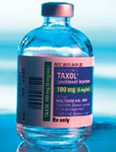
Paclitaxel (Taxol)
Paclitaxel is a drug used experimentally in mesothelioma treatment. It may be an effective substitute for pemetrexed (Alimta) in pleural mesothelioma chemotherapy. Some peritoneal mesothelioma patients have benefited from follow-up paclitaxel treatments after surgery.

What Is Paclitaxel?
Paclitaxel is used in the treatment of all four types of asbestos-related cancer, including mesothelioma, lung, ovarian and laryngeal cancer. The U.S. Food and Drug Administration has approved it as a treatment for several cancers, including breast, ovarian, pancreatic, non-small cell lung cancer and AIDS-related Kaposi’s sarcoma.
Doctors also use it as an experimental or off-label treatment for mesothelioma, laryngeal, bladder, melanoma, esophageal and prostate cancer. Paclitaxel is commonly given in combination with cisplatin or carboplatin.
As of 2024, clinical trials are investigating paclitaxel as a treatment for pleural and peritoneal mesothelioma. These trials combine paclitaxel with immunotherapy drugs for pleural patients or apply it directly to the lining of peritoneal patients.
In general, chemotherapy drugs disrupt the division of cells that divide quickly. This prevents cancer cells from replicating and growing.
Paclitaxel is an antimicrotubule agent. Microtubules are essential to cell division. Paclitaxel binds to proteins in cell microtubules to prevent cell division and growth. This action causes cancer cells to die because they can’t divide.
Paclitaxel’s primary benefits include improved survival and reduced cancer symptoms. It improves survival by killing cancer cells and limiting their growth, potentially reducing the size of tumors. Shrinking tumors also improves the symptoms they cause.
Paclitaxel Information
The development of this drug dates back to the late 1960s when it was discovered in the bark of the Pacific yew tree. Researchers recognized its potential as an anti-cancer agent, but its natural scarcity made it challenging to market.
More than 20 years later, researchers found a way to produce paclitaxel synthetically in a lab. Bristol-Myers Squibb began marketing it as Taxol in the early 1990s, and generic versions of the drug are now available.
| Name | Taxol, Abraxane |
| Manufacturer | Bristol-Myers Squibb, Celgene |
| Medical Code | J9267 |
| Dosage | 135 mg/m² |
| Administration Route | Intravenous or intraperitoneal |
| Active Ingredient | Paclitaxel |
| Drug Class | Antineoplastic agent, antimicrotubule agent |
| Related Drug | Docetaxel |
| Alternate Names | Anzatax, Asotax, Bristaxol, Onxol, Praxel |
| Interacting Drug | Adenovirus types 4 and 7 live, antihistamines, apalutamide, eluxadoline, idarubicin, idelalisib, influenza virus vaccine trivalent, ivacaftor, nefazodone, opiates, palifermin, quinidine |
| Medical Studies | Intraperitoneal Paclitaxel for Patients With Primary Malignant Peritoneal Mesothelioma (INTERACT MESO) |
| FDA Warning | Skin problems, hives, acute allergic reaction characterized by breathing difficulty and low blood pressure |
In 2005, the FDA approved a new type of drug called nanoparticle albumin-bound paclitaxel, or nab-paclitaxel. In this formulation, the drug is contained in tiny particles of protein. This improves drug delivery and reduces side effects. Celgene Corporation markets nab-paclitaxel as Abraxane.

Paclitaxel for Pleural Mesothelioma Treatment
Clinical trials are recruiting pleural mesothelioma patients to test paclitaxel with two new immunotherapy drugs called NX-1607 and LMB-100. Researchers are testing the original formula of paclitaxel and the newer formula Abraxane in combination with other drugs. Additionally, a 2023 Italian test-tube study showed that stem cells loaded with paclitaxel are more effective against mesothelioma cells than the original formula of paclitaxel.
In 2021, the FDA granted orphan drug designation to ONCOFID-P, a combination of paclitaxel and hyaluronic acid. Preclinical data shows ONCOFID-P is more effective in reducing mesothelioma tumor mass than paclitaxel alone.
Past studies have reported benefits including improved pleural mesothelioma survival and symptoms. Research has found paclitaxel combined with other drugs is more effective for pleural mesothelioma than paclitaxel alone. Standard chemotherapy for mesothelioma combines pemetrexed with cisplatin or carboplatin, but pemetrexed is too toxic for some patients. Some pleural patients respond well to Abraxane with carboplatin as a second-line therapy.
Paclitaxel for Peritoneal Mesothelioma Treatment
Researchers have studied paclitaxel for peritoneal mesothelioma as well. Peritoneal patients may join trials testing paclitaxel as a single intraperitoneal chemotherapy drug or in combination with cisplatin applied as pressurized intraperitoneal aerosol chemotherapy.
A 2021 clinical research study concluded that large doses of intraperitoneal paclitaxel, up to 120 mg every month or 60 mg weekly, can be combined with cisplatin and other systemic agents with minimal or no additional hematologic toxicity.
A 2020 report co-authored by peritoneal mesothelioma expert Dr. Paul Sugarbaker described the long-term survival of six patients who received normothermic intraperitoneal chemotherapy (NIPEC) with paclitaxel for 6 months following surgery with hyperthermic intraperitoneal chemotherapy (HIPEC). Four patients showed no signs of cancer at 8, 13, 18 and 19 years after treatment, and two patients died 15 years after treatment.
Sugarbaker’s past research on paclitaxel also shows better outcomes for patients who receive long-term paclitaxel. In these follow-up treatments, the drug is delivered to the abdomen to prevent cancer reoccurrence.
Peritoneal specific questions I encounter commonly are what is the NIPEC procedure and how does a doctor determine whether that is done or not? Do they need further chemo after NIPEC?

Paclitaxel for Other Asbestos-Related Cancers
Paclitaxel is commonly used to treat the other three types of asbestos-related cancer, including lung, ovarian and laryngeal cancer. The FDA has approved paclitaxel for several different types of asbestos-related lung cancer including small cell, non-small cell and non-squamous lung cancer. It is often combined with immunotherapy or other chemotherapy drugs to increase its effectiveness.
The agency approved paclitaxel for advanced cases of ovarian cancer in the 1990s. It is combined with cisplatin as a first-line therapy or as a standalone treatment for patients who have previously undergone other treatments.
Oncologists use paclitaxel with cisplatin and radiation therapy to improve survival outcomes for people with laryngeal cancer. This treatment combination improves overall survival and symptoms like jaw-related problems, eating limitations and facial pain.
Paclitaxel Side Effects
Like most chemotherapy drugs, paclitaxel damages healthy and cancerous cells. Side effects are usually worse about 15 to 21 days after treatment.
Common Side Effects of Paclitaxel
- Low red- and white-blood-cell counts
- Hair loss
- Joint and muscle pain
- Numbness and tingling in extremities
- Nausea and vomiting
- Diarrhea
- Mouth sores
- Severe allergic reaction
Reporting side effects to your oncologist as soon as they develop helps prevent them from worsening. Even if you believe the effect is tolerable or expected, report it anyway. Your medical team can assess the severity of side effects and offer advice or treatment to control them.
Rare Side Effects
While uncommon, report and monitor rare side effects of paclitaxel if any develop. Your medical team can advise whether certain side effects warrant medical attention.
Rare Side Effects of Paclitaxel
- Swelling in feet or ankles
- Liver problems
- Low blood pressure
- Skin darkening at radiation treatment sites
- Nail discoloration
In rare cases of partial tumor response to paclitaxel as a single agent for pleural mesothelioma, there have been reports of cardiac arrhythmias and peripheral neuropathy. These patients’ tumors may have responded better to paclitaxel, but the side effects were significant. Contact your doctor as soon as possible if you experience any serious side effects while taking paclitaxel.
Recommended Reading



